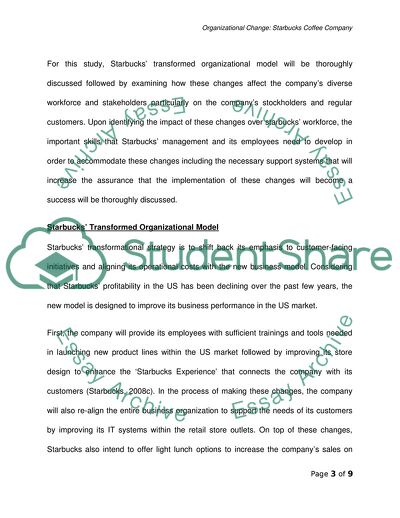
- Home
- Free Samples
- Premium Essays
- Editing Services
- Extra Tools
- Essay Writing Help
- About Us
- Studentshare
- Subjects
- Miscellaneous
- Organizational Change Paper
Organizational Change Paper - Essay Example

- Subject: Miscellaneous
- Type: Essay
- Level: Ph.D.
- Pages: 4 (1000 words)
- Downloads: 0
- Author: virgilhowe
Extract of sample "Organizational Change Paper"
This model enabled the company to develop a highly recognized brand throughout the global markets. As a result of globalization, unemployment rate throughout the US increased from 5.7% in 2007 up to 6.1% in 2008 (Bureau of Labor Statistics, 2008). Considering that a large number of Americans need to cut down on unnecessary expenses, Starbucks US is currently experiencing profit loss over the last few years (MSN Money, 2008). Aside from the significant decrease in its net income, the company also experience a negative US$0.
03 per share between the years 2007 and 2008 (Financial Post, 2008; MSN Money, 2008). For this reason, Starbucks’ management has recently developed a transformed organizational model to counteract the negative effects of the US economic position over the profitability of the business. For this study, Starbucks’ transformed organizational model will be thoroughly discussed followed by examining how these changes affect the company’s diverse workforce and stakeholders particularly on the company’s stockholders and regular customers.
Upon identifying the impact of these changes over starbucks’ workforce, the important skills that Starbucks’ management and its employees need to develop in order to accommodate these changes including the necessary support systems that will increase the assurance that the implementation of these changes will become a success will be thoroughly discussed. Starbucks’ transformational strategy is to shift back its emphasis to customer-facing initiatives and aligning its operational costs with the new business model.
Considering that Starbucks’ profitability in the US has been declining over the past few years, the new model is designed to improve its business performance in the US market. First, the company will provide its employees with sufficient trainings and tools needed in launching new product lines within the US market
...Download file to see next pages Read More
- TERMS & CONDITIONS
- PRIVACY POLICY
- COOKIES POLICY